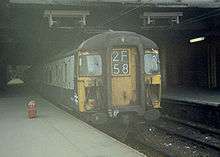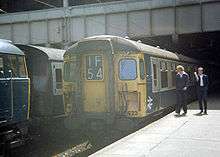British Rail Class 309
| British Railways AM9 British Rail Class 309 Clacton Express | |
|---|---|
|
309 625 leading the usual 10-car set (two 4-car sets – one with a buffet car – and one 2-car set) at London Liverpool Street on 21 March 1981 | |
| In service | 1962–2000 |
| Manufacturer | BR |
| Order number |
|
| Built at | |
| Constructed | 1962–1963, 1973-1974, 1980-1981,[2] 1987[3] |
| Entered service | 1962[1] |
| Refurbishment | 1985–1987 |
| Number built | 76 cars |
| Formation |
2, 3 or 4 cars per trainset:
|
| Diagram |
|
| Fleet numbers |
|
| Capacity |
|
| Operator(s) | Eastern Region of British Rail |
| Depot(s) | Clacton[2] |
| Line(s) served | Sunshine Coast Line |
| Specifications | |
| Car body construction | Steel[5] |
| Train length |
|
| Car length | 64 ft 6 in (19.66 m) (over body)[4][5] |
| Width | 9 ft 3 in (2.819 m) (overall)[5] |
| Height | 12 ft 9.5 in (3.899 m) (overall)[5] |
| Doors | Slam[4] |
| Wheelbase | 46 ft 6 in (14.173 m) (bogie centres)[5] |
| Maximum speed | 100 mph (161 km/h)[4] |
| Weight |
|
| Traction motors | 4 × GEC WT401 of 210 kW (280 hp)[3][2] |
| Power output | 1,128 hp (841 kW)[4] |
| Train heating | Electric[5] |
| Electric system(s) | 25 kV AC OHLE |
| Current collection method | Pantograph |
| UIC classification |
|
| Bogies | Commonwealth[4] |
| Braking system(s) | Air (EP/Auto)[4] |
| Coupling system |
|
| Multiple working | Classes 302–312[4] |
| Track gauge | 1,435 mm (4 ft 8 1⁄2 in) standard gauge |


The British Rail Class 309 "Clacton Express" electric multiple units (EMUs) were built by British Rail (BR) York Carriage Works from 1962–1963. They were initially classified as Class AM9 before the introduction of TOPS. These units were the first express 25 kV alternating current (AC) units to be built by British Rail, and British Rail's first EMUs to be capable of 100 mph.
Description
Twenty-three units were built in three different configurations:
- 601–608 – Two-car units (309/1)
- 611–618 – Four-car units containing a griddle car (309/2)
- 621–627 – Four-car units (309/3)
Each unit had identical electrical equipment. The original concept called for increasing the power-to-weight ratio when strengthening trains from eight to ten cars in peak periods using the 2-car units, in order to make the peak timetable more resilient.
Operations
When built, units were used exclusively on Great Eastern Main Line (GEML) express services from London Liverpool Street to Clacton-on-Sea and Walton-on-the-Naze (also marketed as the Sunshine Coast Line). Trains would be formed of three units in a ten-car formation (i.e. one two car unit, and two four car units). The train would divide at Thorpe-le-Soken, with one of the 4-cars units used on the Walton section, and the remaining six cars continuing to Clacton. The Clacton portion usually included the griddle car unit, and was always the second to leave Thorpe-le-Soken, being the rear (London end) portion of the coastbound train.
In the 1970s many of the units were reformed. The two-car units were augmented to four-car units. In 1973-74 units 605-608 with the addition of TSK with TCK converted former Mk1 SK and CK coaches which formed in to 4 car sets. In 1978 units 601-604 with the addition of TCK and TSOL converted former Mk1 CK and TSO coaches which formed in to 4 car sets. In the early 1980s units 611-618 had the griddle cars were taken out of use and replaced by TSOL from 601-604 and TSK from 605-608. 601-608 where augmented to 3-car units until refurbishment work in 1985-86 In 1986-87 refurbishment work required the addition of 8 Mk1 TSO coaches to be converted to TSO trailers for units 611-618 with the borrowed TSOL and TSK trailers all being converted to TSOL trailers and reformed back into 601-608.
The entire fleet was refurbished in the period 1985–1987. The first units outshopped were painted in the bold new London and SouthEastern "Jaffa Cake" livery. However, this was soon superseded by the equally bold Network SouthEast livery, which was introduced in 1986. Coinciding with the refurbishment work, in 1985 electrification spread north from Colchester to Ipswich, and later to Harwich and Norwich. This meant the Class 309 units were soon introduced on fast trains to Ipswich and Harwich.
In 1989, new Class 321/3 units were introduced onto GEML services partially replacing both class 309 and Class 312 diagrams. The "Clacton Express" units however continued until May 1992 in main service and then a reduced fleet operated a few rush hour services until January 1994. The last units were withdrawn on 22 January 1994, despite their recent and expensive refurbishment. After working a final railtour (15 January 1994) and the week of normal services a final Saturday diagram was run with 309626/613/616 ending on the 1800 Liverpool Street - Clacton.[6] However, not all units were immediately scrapped, and seven were retained for possible reuse around Manchester on suburban trains. These units were stored at Blackpool.
In 1994, Regional Railways North West (RRNW) acquired the seven redundant units stored at Blackpool. The units, nos. 309613/616/617/624/626/627, were quickly put to use on suburban passenger services from Manchester Piccadilly to Crewe and Stoke-on-Trent. Six of the units were repainted in RRNW blue livery with a green stripe. The seventh, no. 309624, was repainted in a special blue livery to commemorate the opening a new railway line to Manchester International Airport in 1996. Upon privatisation, the units passed to the North Western Trains (NWT) franchise. This was later renamed First North Western (FNW) following FirstGroup taking 100% ownership of Great Western Holdings.
By the late 1990s, the seven units saw continued use around Manchester. They also saw some use on longer distance services, with one booked daily Manchester Piccadilly-Birmingham International service and return. On occasion, units were used on NWT's Manchester-London Euston service, deputising for a non-available Class 322 unit. At one point, it was planned to use the units on a new Crewe-Carlisle stopping service, but this did not happen. However, the end was in sight, because as part of their franchise commitment, FNW had to replace their slam-door rolling stock, including the Class 309 units. New Class 175 diesel multiple units were introduced in 1999–2000, and FNW discontinued its Manchester-Euston service. This meant that the "Clacton Express" units were surplus to requirements. As a farewell gesture, three units were used on a final railtour from Manchester to their old haunt of Clacton-on-Sea via London Liverpool Street. Following this tour, all seven units were withdrawn in late 2000, and sent for storage at MoD Pig's Bay near Shoeburyness. Two of the units later saw further use in departmental service, whilst the remaining five were scrapped in 2004.
Further use
Following withdrawal from normal service, two units were converted to Class 960 departmental units in 2001 for further use as cab-signalling test units. The two units concerned were reduced in length to 3-car units, and were based at the test track at Old Dalby in Leicestershire. Both units were painted in a blue and white livery.
- 960101 (ex-309616) - named "West Coast Flyer"
- 960102 (ex-309624) - named "New Dalby"
They were withdrawn in 2004 following completion of the tests. both were stored at MoD Pig's Bay, near Shoeburyness, Essex, until early 2009 when they finally entered preservation.
Preservation
- 960101 (ex-309616) - Electric Railway Museum, Warwickshire
- 960102 (ex-309624) - Electric Railway Museum, Warwickshire
References
- 1 2 3 Longworth 2015, pp. 72, 135-136, 150-151, 157, 168, 170-171, 181, 186-187
- 1 2 3 4 Fox 1994, pp. 13-14
- 1 2 Swain 1990, pp. 47-48
- 1 2 3 4 5 6 7 8 9 10 11 12 "Class 309". The Railway Centre. Archived from the original on 14 October 2007. Retrieved 26 February 2016.
- 1 2 3 4 5 6 7 8 "Vehicle Diagram Book No.210 for Electrical Multiple Units (including A.P.T.)" (PDF). Barrowmore MRG. BRB Residuary Ltd. ED265, EE160, EE273, EH288, EH289. Retrieved 26 February 2016.
- ↑ Gensheet Class 309 history page
Sources
- Fox, Peter (1994). Electric Multiple Units. British Railways Pocket Book No.4 (7th ed.). Platform 5. ISBN 978-1-872524-60-3.
- Longworth, Hugh (2015). British Railways Electric Multiple Units to 1975. Oxford Publishing Co. ISBN 978-0-86093-668-8. OCLC 923205678.
- Swain, Alec (1990). Overhead Line Electric Multiple Units. British Rail Fleet Survey. 11. Ian Allan. ISBN 978-0-7110-1902-7. OCLC 315344213.
- Mallaband, P (1976). Coaching Stock of British Railways. Coaching Stock of British Railways. Railway Correspondence and Travel Society. ISBN 9780901115393.
- Mallaband, P (1978). Coaching Stock of British Railways. Coaching Stock of British Railways. Railway Correspondence and Travel Society. ISBN 978-0-901115-44-7.
- Mallaband, P (1980). Coaching Stock of British Railways. Coaching Stock of British Railways. Railway Correspondence and Travel Society. ISBN 978-0-901115-50-8.
- Mallaband, P (1981). Coaching Stock of British Railways. Coaching Stock of British Railways. Railway Correspondence and Travel Society. ISBN 978-0-901115-51-5.
- Mallaband, P (1982). Coaching Stock of British Railways. Coaching Stock of British Railways. Railway Correspondence and Travel Society. ISBN 978-0-901115-56-0.
- Fox, Peter (1985). Locomotives & Coaching Stock. British Railways Pocket Book. Platform 5. ISBN 978-0-906579-45-9.
- Fox, Peter (1987). Locomotives & Coaching Stock. British Railways Pocket Book. Platform 5. ISBN 978-0-906579-67-1.
Further reading
- Kelly, Peter (August 1983). "Unsung heroes of the 100mph elite". Rail Enthusiast. EMAP National Publications. pp. 41–42, 51. ISSN 0262-561X. OCLC 49957965.
- Jackman, D. (August 1983). "'Rear four coaches for Clacton...'". Rail Enthusiast. EMAP National Publications. pp. 52–54. ISSN 0262-561X. OCLC 49957965.
External links
| Wikimedia Commons has media related to British Rail Class 309. |
.jpg)